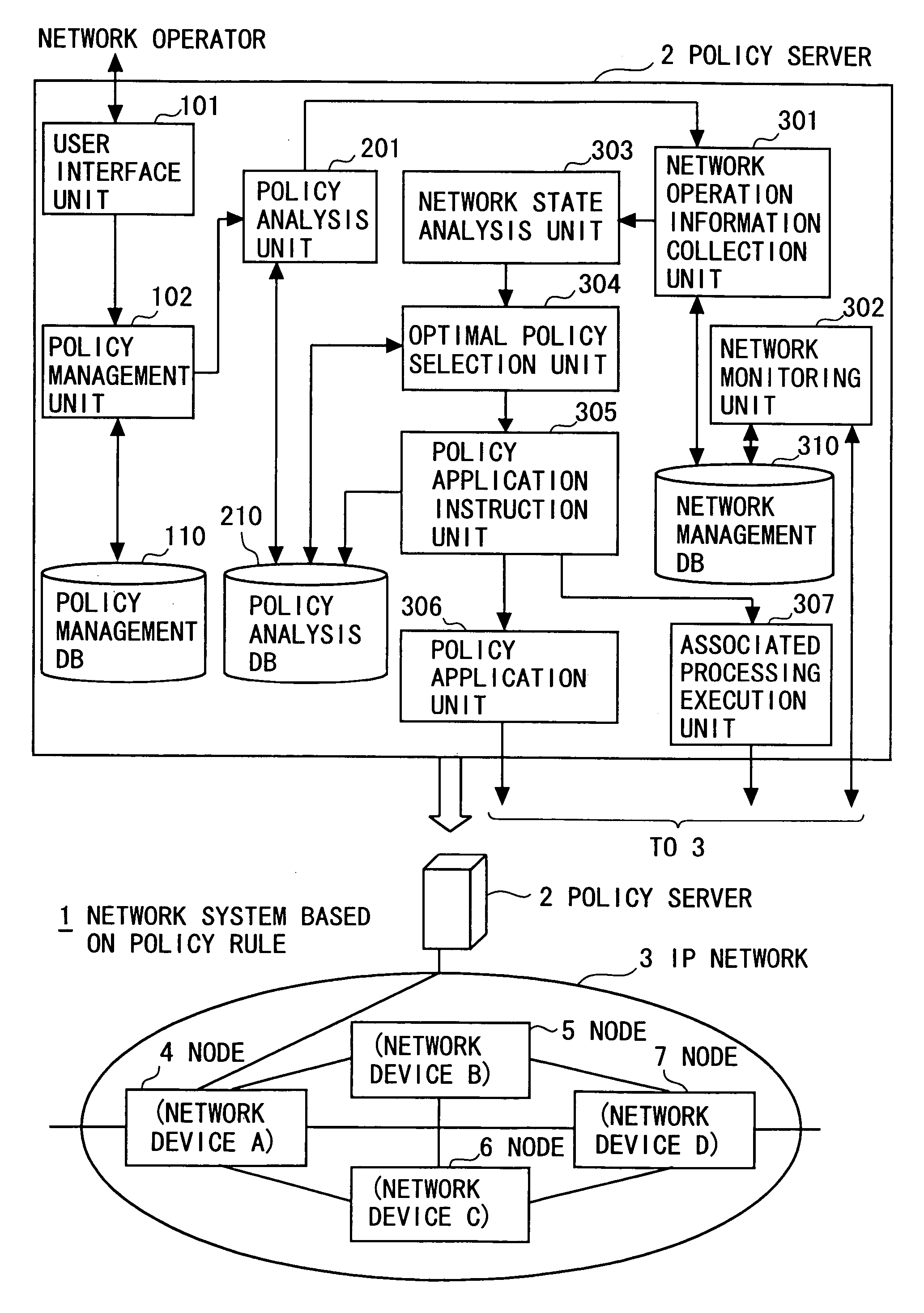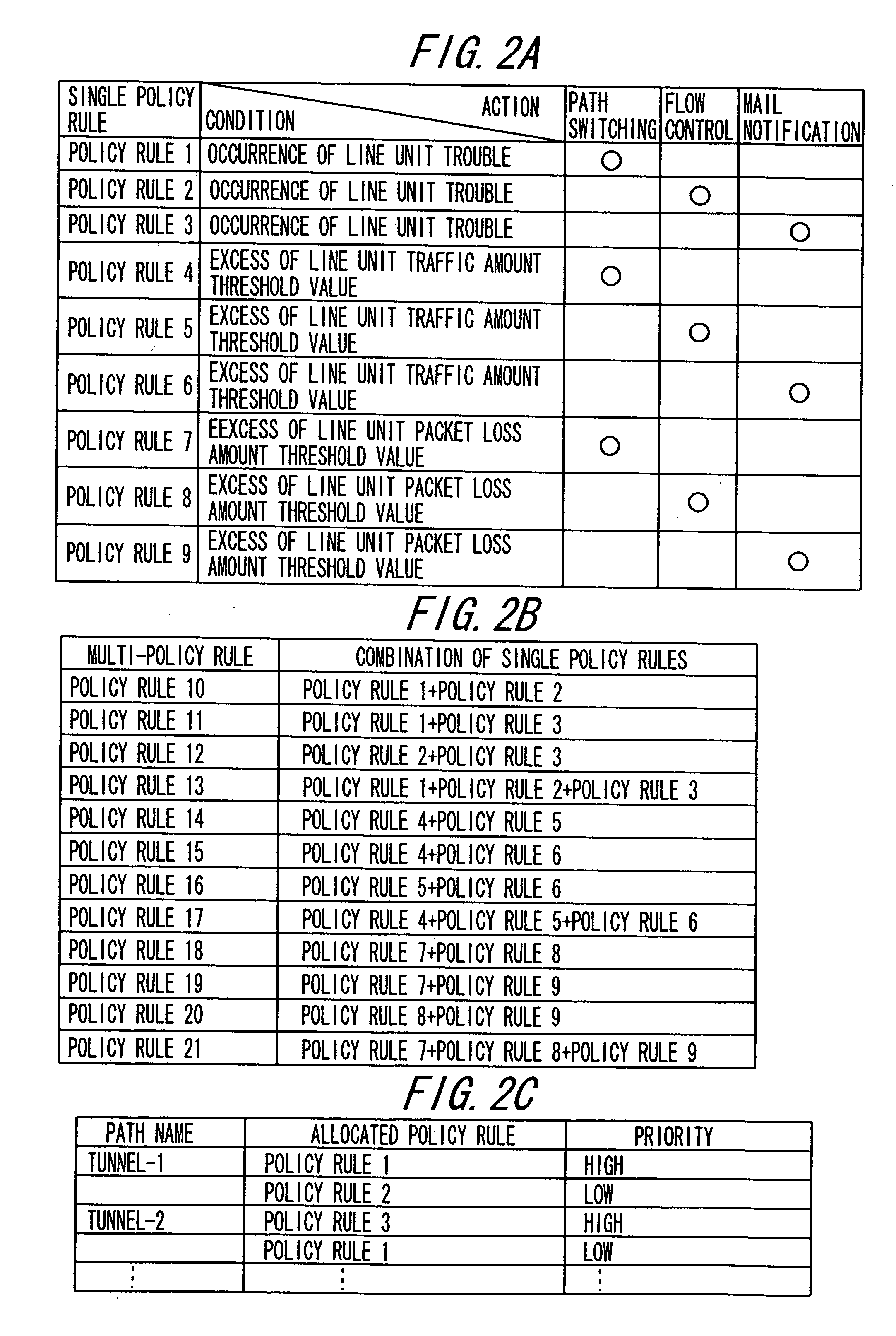Network system based on policy rule
- Summary
- Abstract
- Description
- Claims
- Application Information
AI Technical Summary
Benefits of technology
Problems solved by technology
Method used
Image
Examples
first operation example
[0112] According to the network system 1 based on the policy rule of a first operation example, a multi-policy rule is created by combining single policy rules of the same condition according to an operation purpose, with the result that the IP network 3 diversified and instantaneously changed in state can be flexibly controlled.
[0113] As shown in FIG. 3, the network operator utilizes the maintenance / operation terminal connected to the policy server 2 through the IP network 3 to designate “Policy Rule 1” and make a registration request of a policy rule through the user interface unit 101 (S10101 and S10102 shown in FIG. 6). “Policy Rule 1” includes “Condition 1” as a condition indicating occurrence of a line-basis trouble with regard to the traffic (IP flow) flowing from the user terminal X to the user terminal Y through the route 1 and “Action 1” as an action of path switching so that the traffic can flow from the user terminal X to the user terminal Y through the route 2.
[0114] ...
second operation example
[0136] According to the network system 1 based on the policy rule of a second operation example, an order of priority (priority) according to an operation purpose is given to single policy rules of the same condition and application is performed according to the order of priority, with the result that the IP network 3 diversified and instantaneously changed in state can be flexibly controlled.
[0137] As shown in FIG. 4, the network operator utilizes the maintenance / operation terminal connected to the policy server 2 to designate “Policy Rule 4” and make a registration request of a policy rule through the user interface unit 101 (S10101 and S10102 shown in FIG. 6). “Policy Rule 4” includes “Condition 4” as a condition indicating that a traffic amount exceeds a line-basis threshold of 40% with regard to the traffic (IP flow) flowing from the user terminal X to the user terminal Y through the route 1 and “Action 4” as an action of path switching so that the traffic can flow from the us...
third operation example
[0154] As an alternative to the second operation example, the network operator utilizes the maintenance / operation terminal connected to the policy server 2 to create multi-policy rules to which plural kinds of priority (e.g., highest, high, middle, and low) are assigned. For example, as shown in FIGS. 2A and (B), priorities of “Low”, “High”, “Highest”, and “Middle” are respectively assigned to multi-policy rules 10 to 13 created by combining single policy rules 1 to 3 belonging to the same condition regarding “Line-basis Trouble Occurs”.
[0155] The network operator additionally designates a network device (e.g., network device of network device ID “172.27.1.1” and interface ID “172.27.50.1”) to which the multi-policy rules with priority are applied.
[0156] Thus, a policy rule registration request is made to the policy management unit 102 through the user interface unit 101. As a result, as in the case of the application of the single policy rule with priority of the second operation...
PUM
 Login to View More
Login to View More Abstract
Description
Claims
Application Information
 Login to View More
Login to View More - R&D
- Intellectual Property
- Life Sciences
- Materials
- Tech Scout
- Unparalleled Data Quality
- Higher Quality Content
- 60% Fewer Hallucinations
Browse by: Latest US Patents, China's latest patents, Technical Efficacy Thesaurus, Application Domain, Technology Topic, Popular Technical Reports.
© 2025 PatSnap. All rights reserved.Legal|Privacy policy|Modern Slavery Act Transparency Statement|Sitemap|About US| Contact US: help@patsnap.com



